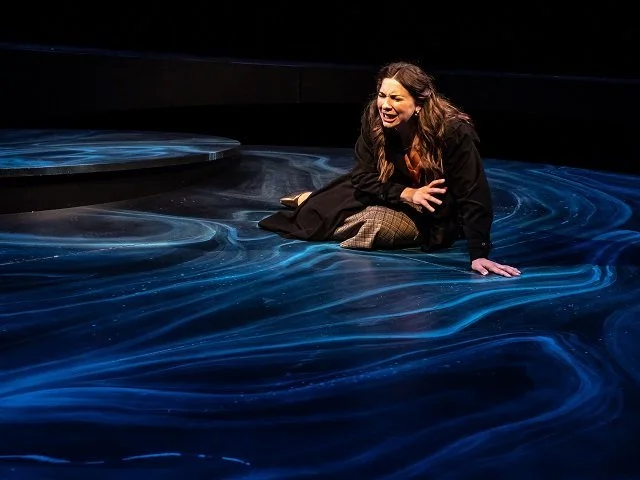APT Asks How? and Why? in "Once Upon a Bridge"
Photo by Liz Lauren
In the aftermath of a tragic event, it’s natural to ask two questions: how and why? In the absence of any explanation or someone to hold accountable the questions persist, repeated ad nauseum by a sensational news cycle.
In 2017, when an oblivious jogger shoved a woman into the path of an oncoming London bus, the incident was caught on surveillance video and the whole country asked how? Why? The man was never identified or apprehended so the questions linger, even now.
This event is the inspiration for Sonya Kelly’s play, Once Upon a Bridge, which was commissioned by the Druid Theatre Company and debuted virtually during the pandemic in Galway. Now American Players Theatre has mounted the American premiere of the compelling three-hander, which runs in the indoor Touchstone Theatre through Oct. 7. Made up of direct-address monologues, the play presents an extensive backstory for the jogger, the pedestrian and the bus driver who swerved just in time to avert disaster. But instead of focusing on the actual traumatic event, this fascinating character study explores the before and after of that day. Directed by APT actor and director Laura Rook, it is a compelling story of three complex people whose lives collide for a split second and are forever altered.
Long before we understand his role in the incident we meet The Man, a cynical financial whiz who is practical in justifying his greed and adept at defending his privilege. A Machiavellian go-getter, he has dreams of wealth, power and status — complete with a home in a posh neighborhood, a beautiful wife and a family.
There are hundreds of easy ways to write him off as the bad guy, but the script, coupled with Marcus Truschinski’s earnest performance, won't let us.
In only just a few speeches, the stakes are raised and his vulnerable, human side is revealed. We understand completely why he was in a hurry, distracted, even panicked that day; why he may have been acting desperate and irrational. Stopping short of pardoning his callous disregard for others, Truschinski charms us as a hard-charging guy who bends the rules a bit for his own purposes. Also, the monologue describing his first encounter with his future wife is particularly enchanting. Though a legal reckoning for The Man’s actions never materializes, the comeuppance he is dealt feels satisfying and his journey from smug finance bro to outcast is fascinating to watch.
Similarly, playwright Kelly gives us deep background on The Bus Driver (La Shawn Banks), whose quick reflexes averted disaster. An immigrant with a family to support, he drives a London double-decker bus, enduring casual racism and overt contempt daily, from both his manager and his passengers. There is also a pointed expectation that while he remains largely invisible as a service worker, he must overperform at his job simply to be tolerated. Ominously, he tells us that he must be the eyes for people who don’t pay attention to their surroundings as he drives.
Banks is captivating as a man who is sustained by his family, but spends precious little time with them due to his long hours. The gentleness he displays with his young daughters is matched by his refusal to be underestimated and later, his fervor for justice, once he’s been given a platform by morning chat shows. Banks’s transformation over the course of the play is extraordinary, from a man who is under-recognized for his hard work daily, to someone who is regaled as a hero for doing the least he could, to a voice for the underrepresented and oppressed.
As interesting and well defined as these characters are, Elizabeth Reese’s turn as A Woman upstages them both as a whirlwind of storytelling. She embodies characters as diverse as a small child, her Irish grandmother, several staid members of a high-power law firm, and a self-assured Irish law student who hides her “leprechaun” accent in order to fit in better with her classmates at Cambridge. Positioned as a firecracker from the beginning, with both family and national scores to settle with the English establishment, Reese’s character is smart, witty, careful and canny. She has worked hard. At the moment she is pushed to the ground, she is on her way to a job interview that could change her life. And instead, she is the target of a random act of violence that changes her life. Reese’s explosive response to her physical injuries and to the injustice her character suffers is stunning. Her resignation when it becomes apparent that her assailant will never be charged is also heartbreaking.
Special kudos for Reese (and the rest of the cast) for keeping a diverse catalog of accents straight as they embodied many people from different countries and classes.
Director Rook keeps the actors moving at a quick pace on several levels of the stylized stage — three overlapping circular platforms that look like trippy blue orbs. (Literal world-colliding set design is by Lawrence E. Moten III.) She centers the actual video footage of the incident and repeats it several times in the middle of the play to drive home the violence, randomness and pedestrian quality of the act. The effort to highlight the common element of dance in the three interwoven stories is less successful and less necessary.
As Rook writes in her director’s notes, it’s nice to think of Once Upon a Bridge as a fairy tale, as suggested by the children’s book, sing-song title. And Kelly gives us a few magical-but-still-plausible moments at the end of the play that suggest good outcomes for two of the three characters. It would be comforting if things happened for a reason, even terrible things. If there was a bigger narrative, where heroes and heroines struggled before they ultimately triumphed. If malicious actions were punished and things turned out well in the end. If there were real answers to how? And why?
